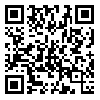دوره 21، شماره 2 - ( 3-1403 )
جلد 21 شماره 2 صفحات 36-33 |
برگشت به فهرست نسخه ها
Ethics code: IR.TBZMED.REC.1399.1034
Download citation:
BibTeX | RIS | EndNote | Medlars | ProCite | Reference Manager | RefWorks
Send citation to:



BibTeX | RIS | EndNote | Medlars | ProCite | Reference Manager | RefWorks
Send citation to:
Baradarani T, Roshangar F, Jabbarzadeh Tabrizi F, Sarbakhsh P, Parvan K. Diagnostic thinking and its association with clinical competence among Iranian nurses in emergency departments. J Res Dev Nurs Midw 2024; 21 (2) :33-36
URL: http://nmj.goums.ac.ir/article-1-1672-fa.html
URL: http://nmj.goums.ac.ir/article-1-1672-fa.html
Diagnostic thinking and its association with clinical competence among Iranian nurses in emergency departments. Journal of Research Development in Nursing and Midwifery. 1403; 21 (2) :33-36
چکیده: (3200 مشاهده)
Background: Diagnostic thinking and clinical competence are the two main domains of efficient nursing care. This study assessed the association between diagnostic thinking and clinical competence among emergency nurses.
Methods: The present correlation study was conducted in 2020 on 113 nurses working in emergency departments in a northwestern province of Iran over two consecutive years. A stratified random sampling method was used for recruiting nurses. Data was gathered via a demographic questionnaire, the Diagnostic Thinking Inventory, and the Nurse Competence Scale and analyzed using the SPSS 18 software. Pearson's correlation assessed the association between the nurses' diagnostic thinking and clinical competence at a significance level of 0.05.
Results: According to the findings, the nurses’ diagnostic thinking abilities were poor (154.15 ±15.73, range of 150-155), while their clinical competence was good (61.62±18.97, range of 51-75). Significant correlations emerged between thinking flexibility, work role (r=0.22, p=0.017), and memory structure. In addition, thinking flexibility was significantly associated with work role (r=0.22, P=0.017), and memory structure was correlated with teaching-coaching function (r=0.22, P=0.015), diagnostic functions (r=0.25, P=0.006), management of situations (r=0.45, P=0.0001), therapeutic interventions (r=0.42, P=0.0001), regimens (r=0.18, P=0.056), and work role (r=0.4, P=0.0001).
Conclusion: Amplifying thinking procedures and using diagnostic thinking patterns enhance emergency nurses' practice, performance, and clinical competence and promote nursing care. Lecturers and planners must employ modern educational methods to increase nurses' thinking skills and clinical competence.
Methods: The present correlation study was conducted in 2020 on 113 nurses working in emergency departments in a northwestern province of Iran over two consecutive years. A stratified random sampling method was used for recruiting nurses. Data was gathered via a demographic questionnaire, the Diagnostic Thinking Inventory, and the Nurse Competence Scale and analyzed using the SPSS 18 software. Pearson's correlation assessed the association between the nurses' diagnostic thinking and clinical competence at a significance level of 0.05.
Results: According to the findings, the nurses’ diagnostic thinking abilities were poor (154.15 ±15.73, range of 150-155), while their clinical competence was good (61.62±18.97, range of 51-75). Significant correlations emerged between thinking flexibility, work role (r=0.22, p=0.017), and memory structure. In addition, thinking flexibility was significantly associated with work role (r=0.22, P=0.017), and memory structure was correlated with teaching-coaching function (r=0.22, P=0.015), diagnostic functions (r=0.25, P=0.006), management of situations (r=0.45, P=0.0001), therapeutic interventions (r=0.42, P=0.0001), regimens (r=0.18, P=0.056), and work role (r=0.4, P=0.0001).
Conclusion: Amplifying thinking procedures and using diagnostic thinking patterns enhance emergency nurses' practice, performance, and clinical competence and promote nursing care. Lecturers and planners must employ modern educational methods to increase nurses' thinking skills and clinical competence.
| بازنشر اطلاعات | |
 |
این مقاله تحت شرایط Creative Commons Attribution-NonCommercial 4.0 International License قابل بازنشر است. |




